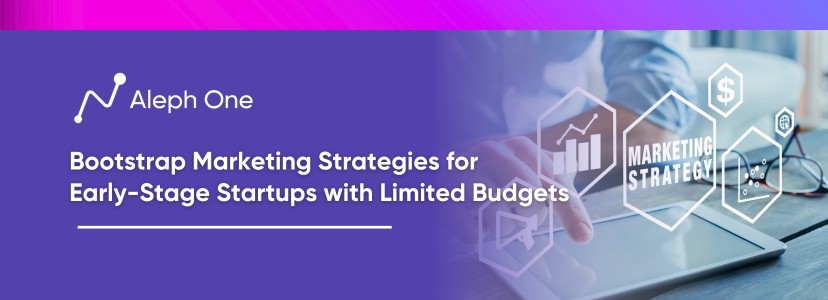Let’s work together to build something amazing. Share your project details and our team will reply to figure out the next steps to your success.

Getting customers to see a startup’s tech product can take time and effort. This article will explore bootstrap marketing strategies for early-stage startups with limited budgets. Learn how podcasting, partnerships, and blogging can be a cost-effective way to establish a startup as an industry leader.

How Podcasting Can Put Your B2B Startup in the Spotlight (For Less Than $100)
Podcasting is an underutilized marketing channel that can help establish your B2B startup as an industry thought leader. Edison Research says over half of all US households are podcast fans. With essential equipment like a USB microphone and free hosting on Buzzsprout or Anchor, you can launch your podcast for less than $100.
A podcast is a perfect platform to share your insights, discuss trends in your industry and promote your brand to a broader audience. You can interview influential guests, answer common questions from your target customers or analyze case studies. The key is to provide value to listeners by educating them on issues they care about.
How to Launch a Podcast for a Startup
When launching your podcast, focus on a specific niche and topic to establish yourself as an expert. For a B2B software startup, you might discuss how to evaluate and implement new technology solutions. A podcast for a consulting firm could explore the latest strategies for improving operational efficiency.
Keep episodes under 30 minutes to be respectful of your audience’s time. Aim for a consistent schedule, such as releasing a new episode every week or every other week. That way, listeners will come to expect and look forward to your show. Promote your podcast across your social media channels, email newsletter, and company blog. Submit your show to podcast directories like iTunes and Stitcher to make it as easy as possible for new listeners to find you.
You can also invite guests to appear on your show in exchange for them promoting the episode to their followers. While it will take time to build up your listenership, a podcast is a proven way for startups to gain exposure and connect with their target customers.
With a small investment of time and money, you can position your brand as a thought leader, highlight your industry expertise and drive more qualified traffic to your website. Podcasting is a marketing channel made for startups looking to bootstrap their growth.
The Impact of Partnerships: How Startups Can Gain Exposure Through Strategic Alliances
As a startup, partnerships are one of the most valuable ways to gain exposure and traction with limited resources. According to a survey by the Content Marketing Institute, 82% of businesses agree that partnerships are crucial to success. Startups should identify other complementary companies and brands to co-create content, co-host webinars, cross-promote to each other’s audiences, and more.
Partnerships are a win-win, allowing both parties to share costs and gain access to new audiences. If you run a SaaS company, team up with a consulting firm to co-author an ebook on trends in your niche. You can promote the ebook to email lists and social media followers.
You might also partner with an influencer or media outlet to be featured on their podcast or YouTube channel. In return, you give them access to your network by promoting their content or services. Look for partners with an overlapping, non-competing audience.
Webinars are another great option for startup partnerships. Co-host a webinar with a complementary company and promote it to the audience. Each company can share insights during the webinar and promote the other as a trusted partner. Webinars build authority, allow you to capture new leads, and strengthen your partnership.
While large companies often have the resources to do it alone, startups should leverage the power of partnerships whenever possible. Look for strategic alliances to help raise brand awareness, decrease costs, reach new potential customers, and boost your credibility through association. With the right partners by your side, startups can gain valuable exposure and traction to help fuel their growth.
How to Build a Blog that Attracts Highly-Qualified Leads
With a blog, you can establish your startup as an industry thought leader and drive organic traffic. Focus on topics your target customers care about, include keywords in your posts, and promote new content on social media. A regular blogging schedule, e.g., 2-3 posts a week, will keep your audience engaged.
To build a successful blog, determine your content strategy and topics that will resonate with your target audience. For a B2B SaaS startup, you should focus on trends in your industry, actionable tips for your customers, or case studies highlighting how you solved key challenges. Optimize your posts for search engines by including essential keywords in titles, headers, and content. Aim for posts that are at least 500 to 1000 words to achieve good SEO rankings.
Next, establish a consistent blogging schedule to keep your audience engaged. Posting 2 to 3 times weekly is a good target for most startups. Consider content clusters where you publish a series of related posts. For example, a 5-part series on “The Top Challenges Facing [Your Industry] in 2020.” Content clusters perform well in search and keep readers coming back.
Promote your blog content on social media to increase traffic. Share posts on platforms where your target audience is active, like LinkedIn, Twitter, and Facebook. Engage with readers who comment on your posts by replying to their comments and starting a discussion. You can also reach out to influencers in your industry and ask them to share your content with their followers.
Track key metrics like pageviews, unique visitors, and bounce rates to see how people engage with your blog. Pay attention to which posts generate the most traffic and use that insight to shape your future content strategy. You can also place call-to-action buttons in your posts, like “Request a Demo” or “Contact Us,” to turn high-quality blog traffic into leads.
With a strategic blog, startups can position themselves as thought leaders, drive consistent website traffic, and generate sales leads—all through organic content creation and social sharing. Focusing on your audience’s needs, optimizing for search, and promoting your posts are the keys to blogging success.
Livestreaming: How to Connect With Your Audience in Real Time (For Free)
Livestreaming video is an easy, free way for early-stage startups to engage with their audience in real-time. According to a recent survey, 80% of internet users watch live video streams. Platforms like LinkedIn Live, Facebook Live, and YouTube Live simplify sharing live video updates with your followers.
As a startup, livestreaming offers many benefits. It allows you to build authentic relationships with your audience by giving them a behind-the-scenes look at your company. You can share updates on new products, milestones, or company events.
You can also host live Q&A’s or “ask me anything” sessions to address questions from your followers. Interviewing industry experts or influencers on your livestream is an excellent way to provide value to your audience while promoting your brand.
To get started with livestreaming, determine your goals and target audience. Do you want to boost brand awareness, drive traffic to your website, or generate new leads? Choose a platform where your target audience spends time, like LinkedIn for B2B or Facebook for B2C. Keep your livestreams short, around 10 to 15 minutes. Promote your livestream on social media ahead of time so people know to tune in.
During your livestream, be authentic and engage with viewers by responding to their comments and questions. Share valuable insights or behind-the-scenes footage that your audience can’t get anywhere else. Keep things light and casual—livestreaming should be an easy, low-pressure way to connect with your community.
Livestreaming is a growth hack that startups can leverage to gain traction and exposure. While building an audience with live video takes time, it is a free marketing channel that allows you to form genuine relationships with your followers.
With a regular livestreaming schedule, you can boost brand awareness, drive more traffic to your website, and ultimately generate new leads for your business. For early-stage startups, that level of engagement and connection is invaluable.
How to Growth Hack Your Way to Traction: 5 Social Media Strategies for Startups
While paid advertising campaigns can be expensive, startups can gain initial traction through organic social media marketing. Here are five growth hacking strategies to employ:
1) Curate and Share Valuable Content
Identify content that interests and benefits your target customers, like blog posts, videos, infographics, etc. Share this content on your social media profiles with insightful comments or questions to spur engagement. This provides value to your followers and positions your startup as a helpful resource.
2) Engage With Your Followers
Social media is meant to be social. Like and comment on your followers’ posts, reply to their comments, and tag them. Engaging with your audience helps to build personal connections and loyalty. Ask followers questions to get conversations started and gain valuable customer insights.
3) Optimize Your Profiles
Choose a consistent and professional profile photo and cover image for your startup across platforms. Write an optimized bio or profile summary that includes your company mission and value proposition. Ensure all profile information, like your website URL, location, and contact info, is current. Well-optimized profiles establish your credibility and make it easy for visitors to learn more about your company.
4) Join Relevant Conversations
Search for hashtags, groups, and discussions your target customers participate in. Share your insights and expertise by posting content or engaging in these conversations. For example, if your startup is in technology, join discussions in tech-focused groups and use hashtags like #tech and #startups. Participating in relevant conversations is a great way to raise brand awareness and connect with potential new followers.
5) Collaborate With Industry Influencers
Identify influencers like bloggers, journalists, and leaders in your industry. Engage with them by liking and commenting on their posts and sharing their content with your followers. Once you have built a connection, explore collaboration opportunities through guest blogging, co-creating content, podcast interviews, or product giveaways. Partnerships with influencers allow you to tap into their audiences and gain credibility through their endorsements.
While paid advertising has a place in startup marketing, organic social media strategies can effectively gain initial traction. By delivering value, engaging their followers, optimizing their profiles, joining conversations, and collaborating with influencers, startups can increase website traffic, build brand awareness and generate new leads through social media. With time and consistency, these growth hacking techniques will drive exponential results.
SEO and Analytics: Drive More Qualified Traffic to Your Startups Website
As a startup, driving qualified traffic to your website is essential for growth. According to studies, nearly half of all website traffic comes from organic search. Optimizing your website for search engine optimization (SEO) and analyzing visitor data can increase the amount of targeted traffic to your site.
To improve your SEO, include essential keywords for your business and industry in page titles, headers, and content. Ensure each page has a clear topic and keywords, and use internal linking between pages to help search engines discover all your content. Fast load times, mobile optimization, and secure HTTPS improve your SEO ranking.
Monitor analytics platforms like Google Analytics to see how visitors find and interact with your website. Look at traffic sources, keywords used, pageviews, bounce rates, and conversion metrics. See which content and traffic channels perform best, and double down on those areas. Likewise, see which areas need improvement and make changes to engage your audience better.
With regular SEO optimization and data analysis, you can refine your strategy over time to drive more qualified traffic. Some areas to focus on include:
- E-A-T: Produce content that shows your Expertise, Authoritativeness, and Trustworthiness. This helps establish your startup as a leader in your industry.
- Skyscraper content: Create more in-depth and comprehensive content than other resources on the topic. This type of content earns high rankings and lots of links.
- Internal linking: Link your content to help search engines discover all your pages. But avoid over-linking, as this can seem unnatural.
- Guest blogging: Pitch guest posts to industry publications to increase referral traffic and build backlinks. Aim for 1-2 high-quality guest posts per month.
- Social sharing: Make your content easy to share on social media to drive referral traffic. Include share buttons, shareable images, and attention-grabbing headlines.
- Conversion rate optimization: Once you get traffic to your site, ensure visitors can easily find what they need. Improve your calls-to-action, forms, and checkout process to turn more visitors into leads and customers.
With an SEO and analytics-focused strategy, you can gain insight into what’s working, make data-driven decisions, and optimize your startup’s website to increase qualified traffic and fuel growth. The key is to start with the fundamentals and refine them over time based on the data.
Are you Ready to Bootstrap Your Startups Marketing?
From podcasting, partnerships, blogging, livestreaming, and SEO, founders can take these affordable and organic options to get their product in front of their audience. Marketing doesn’t have to be expensive or time-consuming with the right strategy; founders can take their startup to the next level.
Get the latest news and updates from Aleph One in your inbox.



